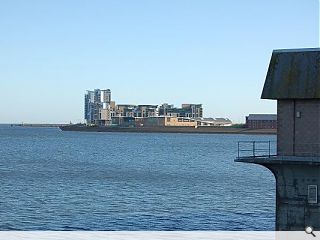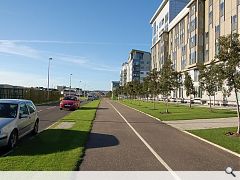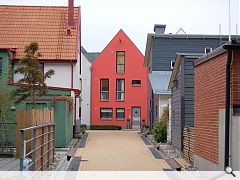Scotland vs Sweden
7 Dec 2010
“I must go down to the seas again, to the lonely sea and the sky,”
(all I ask is a tall ship and a star to steer her by)
When John Masefield wrote these words in 1916, he expressed the intrinsic lure which the sea holds for humanity. No less true today, many cities from Oslo to Lisbon have ambitious plans to reconnect with their waterfronts, often taking advantage of large areas of underused land close to city cores. Edinburgh is currently undertaking one of the largest waterfront developments in Europe, the scope of which rivals the creation of its 18th century New Town. Master plans abound and as initial buildings are now complete, the current recession provides an opportunity to reflect and plan the next moves.
Analysis however shows a surprising range of parallels. Both occupy brown field land and were developed, during a similar era, on exposed seafronts with similar climatic challenges. They architecturally address this with a wall of larger buildings facing the sea, with smaller development “sheltering” behind. They both have serious connection problems, as new areas have been commenced at the sea edge with the connecting infill following later. Interestingly, both use architecture of varying forms with a wide pallet of materials, sometimes creating an almost baroque richness and both seek the iconic statement and could have done better with it.
The key to Malmo’s success is that of civic ambitions. The city’s residents go to the waterfront to find cafés and restaurants, but primarily public space in which to play, contemplate and even jump into the water with some degree of safety. This ambition also provides public transport and a high sustainability agenda. In essence the project is conceived to enhance the city as a whole.
The lack of these core objectives is evident in what has been produced so far in Edinburgh. This is well illustrated by a simple walk along the sea front. In Malmo’s case this is a generous public space and you can engage in activities along the whole length of it. In the case of Edinburgh this has been reduced to a private car park with a joyless narrow walkway providing “circulation” over much of its length. The public dimension has been squeezed to the absolute minimum and “public facilities” have been reduced to an apartment sales office which doubles as a café.
One major objective which the Malmo project addressed from the outset was to create an integrated and mixed community. So far this has not been achieved in Edinburgh, where a new group of residents is obviously trying hard to bond into a community in an isolated environment. The lifestyle the developments provide, of underground car park with lift access to apartments is popular (and appropriate) for some groups within society and a necessary component in the choice of city lifestyles. However, too much in the one place, without shared amenities undermines all concepts of creating sustainable communities and here the feeling of monoculture is just too strong.
One of the major architectural differences between the projects is that Malmo is based on a designed pedestrian circulation system based on human perceptions, such as distance to the shops, creation of limited vistas and streets where pedestrians have priority. This creates a network of spaces that people feel comfortable using. A few weeks ago I listened to designer Klas Tham speaking on the design of Malmo and the sheer amount of effort put into creating this system was in sharp contrast to the basic circulation of wide tree lined boulevard and lack of spatial hierarchy evident the Edinburgh model.
To be fair to Edinburgh, it is less complete than Malmo and the economic collapse has not helped. The most considered part of the development (a master plan by Robert Adam Architects) has yet to get meaningfully underway. As in Malmo, this will create a contrasting form to the sea edge buildings. Predicated on a traditional streetscape of closed perimeter blocks and incorporating an urban park, it will help to create a more successful neighbourhood. Many of Edinburgh’s problems, such as the lack of meaningful connection between the existing townscape and the new development, were outside the control of the developers. Roads created under purely transport agendas create barriers and a range of individual developments over the last 20 years has created a legacy of isolation which new development has to overcome. In contrast, Malmo had almost nothing close to it, so has the opportunity to design connection to the city in a much less problematic way.
So how does this happen? Well, we are looking at two completely different processes. Vastra Hamnen included the Bo01 project, a European housing exposition which provided a national focus, finance and a driver for quality. In contrast, Edinburgh’s project followed the conventional line of private landowner creating a commercial development. However, It is just too easy to blame developers and individual designers and these processes ask questions about the role politicians, planners and funding bodies play in developing new cities.
One of the core issues lies in how master plans are defined, particularly when developed by land owners. We have all faced the red line of the “master plan boundary,” a false division that usually leaves a whole raft of vital issues outside. We need to distinguish between a master plan and what is often just a large site layout. For a master plan to have that status, it should be aiming at a much wider objective and incorporating a range of civic values. To enable this, it is necessary for the city to be much clearer on these wider objectives and enshrine them in long term strategy.
This civic strategy must recognise the value of the sea as a destination. We should heighten the experience, promote its romantic nature, encourage people to stand on the edge of the North Sea and enjoy the salt spray on their face. If you think this is totally mad, just take a look at the top of Arthur’s seat on most days of the year – it’s a major destination for tourists from every part of the globe. Intrinsic to this is the question of response to micro-climate. This whole issue has become such a neglected zone for today’s architects that it will be one of the intriguing questions for future historians. The situation is abundantly clear, the lessons are all there in historic forms and yet too often the issue is totally unrecognised. This has a huge impact on the quality of such developments and a contrast between the sensitivity of Malmo’s approach and what has been produced so far in Edinburgh is both illuminating and depressing.
But can these issues be addressed? We all know there are economic constraints on waterfront development, contaminated land, hostile climate, rising sea levels and high build costs all point towards expensive delivery. We are currently in a position where private developers have their work cut out to stay afloat, the public purse is hardly overflowing with milk and honey and stating that our nearest competitors all seem to do it, appears to do little to persuade people. If these issues are indeed important, we need to quickly devise how this is going to be achieved.
These issues are not “hot news” to most people in the development world. We know that it is about approach as well as simply budget. Currently we are investing vast amounts of money but not really capturing long term value. We know that we create value by creating great places, otherwise why would the New Town of Edinburgh have some of the highest property values in Scotland, or why would Chelsea in London, or the area round Central Park in New York be so commercially valuable?
We have defined the design and civic agendas so many times. What we need now is the long term economic mechanisms, like Tax Incremental Funding which might provide the infrastructure on which many developments are based. But we really need mechanisms to capture the long term value of quality in neighbourhoods and translate it into development budgets and I do know that some of the more inventive estates surveyors are investigating this question.
To paraphrase John Masefield: we now have our tall ship and all we need is an economic star to steer her by!
|
|





